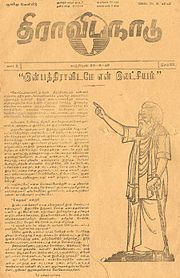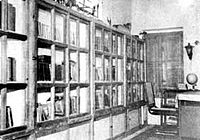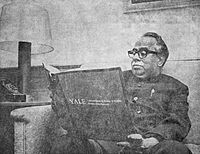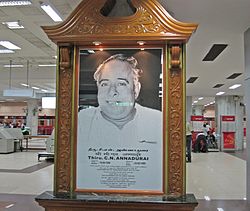- C. N. Annadurai
-
C. N. Annadurai
சி. என். அண்ணாதுரை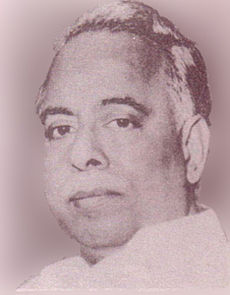
Chief Minister of Madras State(from August 1968 onwards, Tamil Nadu) In office
February, 1967 – 3 February 1969Prime Minister Indira Gandhi Governor Sardar Ujjal Singh Preceded by M. Bakthavatsalam Succeeded by V. R. Nedunchezhiyan (acting) Member of Parliament (Rajya Sabha), India In office
1962–1967President Sarvepalli Radhakrishnan Prime Minister Jawaharlal Nehru,
Lal Bahadur Shastri,
Indira GandhiMember of Madras Legislative Council In office
1967–1969Premier C. N. Annadurai Governor Sardar Ujjal Singh Member of Madras State Legislative Assembly In office
1957–1962Premier K. Kamaraj Governor A. J. John, Anaparambil
Bhishnuram MedhiPreceded by Deivasigamani Succeeded by S. V. Natesa Mudaliar Constituency Kanchipuram Personal details Born September 15, 1909
Kancheepuram, Tamil Nadu, British IndiaDied February 3, 1969 (aged 59)
Chennai, Tamil Nadu, IndiaSpouse(s) Rani Annadurai Children None, but adopted his sister's grandchildren Occupation Politician In this Indian name, the name Conjeevaram Natarajan is a patronymic, not a family name, and the person should be referred to by the given name, Annadurai.Conjeevaram Natarajan Annadurai (Tamil: காஞ்சீபுரம் நடராஜன் அண்ணாதுரை) (15 September 1909 – 3 February 1969), popularly called Anna (Tamil: அண்ணா, “elder brother"), or Arignar Anna (Anna the scholar) was a former Chief Minister of the South Indian state of Tamil Nadu. He was the first member of a Dravidian party to hold that post and was also the first non-Congress leader to form a majority government in independent India.
He was well known for his oratorical skills and was an acclaimed writer in the Tamil language. He scripted and acted in several plays. Some of his plays were later made into movies. He was the first politician from the Dravidian parties to use Tamil cinema extensively for political propaganda. Born in a middle class family, he first worked as a school teacher, then moved into the political scene of the Madras Presidency as a journalist. He edited several political journals and enrolled as a member of the Dravidar Kazhagam. As an ardent follower of Periyar E. V. Ramasamy, he rose in stature as a prominent member of the party.
With differences looming with Periyar, on issues of separate independent state of Dravida Nadu and on inclusion in the Indian Union, he crossed swords with his political mentor. The antipathy between the two finally erupted when Periyar married Maniammai, who was much younger than he. Angered by this action of Periyar, Annadurai with his supporters parted from Dravidar Kazhagam and launched his own party, Dravida Munnetra Kazhagam (DMK). The DMK initially followed ideologies the same as the mother party, Dravidar Kazhagam. But with the evolution of national politics and the constitution of India after the Sino-Indian war in 1963, Annadurai dropped the claim for an independent Dravida Nadu.
Various protests against the then ruling Congress government took him to prison on several occasions; the last of which was during the Madras anti-Hindi agitation of 1965. The agitation itself helped Annadurai to gain popular support for his party. His party won a landslide victory in the 1967 state elections. His cabinet was the youngest at that time in India. He legalised Self-respect marriages, enforced a two language policy (in preference to the three language formula in other southern states), implemented subsidies for rice, and renamed Madras State to Tamil Nadu.
However, he died of cancer just two years into office. His funeral had the highest attendance of any to that date, earning it a Guinness record. Several institutions and organisations are named after him. A splinter party launched by M. G. Ramachandran in 1972 was named after him as Anna Dravida Munnetra Kazhagam.
Contents
Early life
Annadurai was born on 15 September 1909 in Kanchipuram (then called Conjeevaram), Tamil Nadu, to Natarajan and Bangaru Ammal in a middle class family of Sengunthar community.[1] He was raised by his sister Rajamani Ammal. At the age of 21, he married Rani while he was still a student. The couple had no children of their own, so they later adopted and raised Rajamani's grandchildren.[2] He attended Pachaiyappa's High School,[1] but left school to work as a clerk in the town's Municipal office to assist with the family finances.[2]
In 1934, he graduated with a B.A. degree (Hons) from Pachaiyappa's College in Chennai.[1] He then earned a M.A degree in Economics and Politics from the same college.[2] He worked as an English teacher[3] in Pachaiyappa High School. Later he quit the teaching job and began involving himself in journalism and politics.[2]
Religion
By birth Annadurai was a Hindu. The Murugan of the Tiruttani hill temple was the family deity.[4] Though he initially belonged to the openly atheist Dravidar Kazhagam he later nuanced his stance towards theism as "One race, One god" (Onre Kulam Oruvanae Thevan)[5][6]
Annadurai would attack superstitions and religious exploitation but would never fight against the spiritual values of society. He once explained his stance towards god and religion as "I do not break coconuts for Pillaiyar, (a form of worship) neither do I break his idols".(Nan Thengayum udaipathillai; Pillaiyarum Udaipathillai)[7]
Entry into politics
See also: Justice party (India) and Dravidar KazhagamAnnadurai's interest in politics made him join the Justice party in 1935.[8] The Justice party was formed by non-Brahmin elites in 1917.[9] The Justice party originated with the Madras United League which was initially started as a work group that helped non-Brahmin students in Madras with accommodation and later grew into a political party under the efforts of leaders like C. Natesa Mudaliar, Sir Pitti Theagaroya Chetty and Dr. T. M. Nair. The party was named South Indian Liberal Federation (S. I. L. F.) - popularly known as Justice party.[9] The party had been in power in Madras Presidency since self-governance was introduced in 1920, until it was defeated by the Indian National Congress in 1937.[10] By the time Annadurai joined the Justice party, Periyar E. V. Ramasami was the party president.[11] Annadurai served as the sub-editor of the Justice magazine.[2] He later became the editor for Viduthalai (Freedom in English) and was also associated with the Tamil weekly paper, Kudi Arusu. He started his own journal Dravida Nadu (named after the Dravida Nadu - an independent state that the party called for).[2] In 1944, Periyar renamed the Justice party to Dravidar Kazhagam and gave up contesting in the elections.[12]
Differences with Periyar and birth of DMK
See also: Indian independence movement and Dravida Munnetra KazhagamThe Indian National Congress, which had been fighting for the independence of India from colonial British rule, was dominated by Brahmins. Periyar assumed that independent India would bring South Indians, especially Tamils, under the dominance of Brahmins and North Indians.[13] For these reasons Periyar called for 15 August 1947, the day of Indian independence, to be a day of mourning.[14] Annadurai opposed this move and the schism between his supporters and Periyar widened.[13] He saw the gaining of independence as an overall achievement of India rather than solely that of Aryan North.[8] Moreover Periyar's decision on giving up participating in democratic elections was also opposed by Annadurai, in reaction to which he walked out of a party meeting in 1948.[8] Periyar considered that candidates in elections must compromise their ideologies. Moreover, it was Periyar's idea that social reformation can be better achieved outside politics, through education and canvassing the masses, rather than governments.[15] Eventually, when Periyar married Maniammai, who was 40 years younger than he, the personal differences between Annadurai and Periyar split their supporters[15]). Annadurai launched his own party with his party fragment, along with E. V. K. Sampath (Periyar's nephew and until then considered his political heir[16]). The new party was named Dravida Munnetra Kazhagam.[17] DMK's presence was initially restricted to urban centres and its surrounding areas. But by appealing to the urban lower, lower middle and working classes, students, Dalits and lower castes, Annadurai was able to accelerate its growth and spread. He fought for the social justice of the lower castes and thus rapidly gained popular support.[8]
Protests in 1953
In 1953, Annadurai directed the DMK to undertake three protests:[15]
- Condemning Jawaharlal Nehru, the then Prime Minister of India, for describing the tarring of Hindi letters in railway station boards by DK and DMK activists as "childish nonsense"
- Against C. Rajagopalachari (or Rajaji), the then chief minister of Madras State, for introducing a new educational system that indirectly encouraged traditional caste-based occupations called Kula Kalvi Thittam
- Against renaming Kallakkudi, Dalmiyapuram as the name Dalmiyapuram symbolised north Indian domination. He was eventually sentenced to three months imprisonment in this protest.
Dravida Nadu
See also: Dravida NaduDuring his days in Dravida Kazhagam, Annadurai had supported Periyar's call for an independent Dravida Nadu. The claim for such an independent state stayed alive in the initial days of DMK. E. V. K. Sampath, who had earlier forfeited his inheritance from Periyar to join DMK, saw the call for Dravida Nadu as an unrealistic goal. Responding to Sampath's concern, Annadurai said
“ We must contest more elections, win more seats and that way, win the confidence of the people; and when it is hot, we can strike and strike hard[18] ” Sampath's opposition to using film stars made him cross swords with many other members of the party. Eventually, with looming differences with Annadurai and other leaders on Dravida Nadu, Sampath left the DMK and formed his own party, the Tamil Nationalist Party, in 1961.[15] In 1962, Annadurai said in the Rajya Sabha that Dravidians want the right of self-determination ... We want a separate country for southern India.[19]
However, the reorganisation of states in India on linguistic basis removed Kannada, Telugu and Malayalam speaking regions from the Madras Presidency leaving behind a predominantly Tamil Madras State. Giving in to realities, Annadurai and his DMK changed the call of independent Dravida Nadu for Dravidians to independent Tamil Nadu for Tamils. Annadurai felt that remaining in the Indian Union meant accepting linguistic domination and economic backwardness. Nevertheless, the Sino-Indian war brought about changes in the Indian constitution. The Sixteenth Amendment (most popularly known as the Anti-Secessionist Amendment) banned any party with sectarian principles from participating in elections. When this amendment was presented in the Parliament of India, Annadurai was one of its members. He vehemently debated against the amendment, but eventually could not stop it from being passed. Faced with the new constitutional changes, Annadurai and his DMK left the call for an independent Tamil homeland on the back burner.[20] From then on Annadurai and his DMK aimed at achieving better cooperation between the southern states and claimed more autonomy for Tamil Nadu.[21] On the party's position, Annadurai said
“ To make the Dravidian state a separate state was our ideal. A situation has arisen where we can neither talk nor write about this ideal. Of course we can destroy the party by undertaking to violate the prohibition. But once the party itself is destroyed there will not be any scope for the ideal to exist or spread. That is why we had to give up the ideal.[18] ” Anti-Hindi agitations
Hindi was first recommended to be an apt language for official purposes in India by a committee headed by Motilal Nehru in 1928. This move was opposed by people and politicians of Tamil Nadu, since they considered that it would make them second class citizens when compared to that of native Hindi speaking North Indians.[22]
Protests of 1938
In 1938, the Congress government in Madras Presidency headed by C. Rajagopalachari (popularly known as Rajaji) proposed the use of Hindi language as a compulsory language in schools. This move was opposed by Tamil leaders. Annadurai, along with other Tamil enthusiasts including the poet Bharathidasan, held demonstrations. Annadurai participated in the first Anti Hindi imposition conference held in Kanchipuram on 27 February 1938. Two members of the protest, Thalamuthu and Natarajan, died as a consequence of police beating the same year. With overwhelming opposition, the government of Madras Presidency finally withdrew the order in 1940.[23]
Madras Anti Hindi agitation of 1965
Main article: Madras anti-Hindi agitation of 1965When India became a republic with its own constitution in 1950, the constitution had given special status to the Hindi language, which was to gain official status after 15 years in 1965. This move was regarded with anxiety by students in Tamil Nadu.[22] Speaking of making Hindi as official language of India, Annadurai said It is claimed that Hindi should be the common language because it is spoken by the majority. Why should we then claim the tiger as our national animal instead of the rat which is so much more numerous? Or the peacock as our national bird when the crow is ubiquitous?.[24] In view of continued threat to impose Hindi, the DMK held an open-air conference against Hindi imposition at Kodambakkam, Chennai in August 1960, which Annadurai presided over. He gave black flags to leading functionaries, to be shown to the President of India during his visit to the state. Sensing an uprising, Prime Minister Jawaharlal Nehru assured in the Parliament that English would continue to be the official language of India, as long as non-Hindi speaking people desire. DMK gave up the plan of showing black flags and Annadurai appealed to the Union Government to bring about a constitutional amendment incorporating the assurance.[15]
With no constitutional amendment done, Annadurai declared 26 January 1965, the 15th Republic Day of India and also the day the Constitution, which in essence enshrined Hindi as the official language of India, came into practice, as a day of mourning. This move was opposed by the then Chief Minister of Madras State, Bhakthavatchalam, as blasphemous. Hence Annadurai, who by then had been trying to shake off the secessionist image of his party, declared 24 January as a day of mourning. He also replaced the slogan of the protests to Down with Hindi; Long live the Republic. Nevertheless, violence broke out on 26 January, initially in Madurai which within days spread throughout the state.[22] Robert Hardgrave Jr, professor of humanities, government and Asian studies, suggests that the elements contributing to the riots were not instigated by DMK or Leftists or even the industrialists, as the Congress government of the state suggested, but were genuine frustrations and discontentment which lay beneath the surface of the people of the state.[22]
With violence surging, Annadurai asked the students to forfeit the protests, but some DMK leaders like Karunanidhi kept the agitations going.[22] Nevertheless, Annadurai was arrested for instigating the agitation.[15] Although the violence were not directly instigated by the DMK,[22] the agitation itself aided DMK to win the 1967 elections and Annadurai became new the Chief Minister of Madras State.[25]
Literary contributions
See also: Cinema in Dravidian politicsAnnadurai was known as one of the best Tamil orators during his time.[3] He developed a style in Tamil public speaking using metaphors and pleasing alliterations, both in spoken and written language. Anna was also best known for his extempore speaking ability being very well affluent on rhetoric skills.[26]
He has published several novels, short stories and plays which incorporate political themes.[3] He himself acted in some of his plays during his time in the Dravidar Kazhagam.[27] He introduced movie media as a major organ for propaganda of Dravidian politics.[28] In total Annadurai scripted six screen plays.[27]
His first movie Nallathambi (Good Brother, 1948) which starred N. S. Krishnan promoted cooperative farming and abolition of zamindari system.[27] His novels such as Velaikaari (Servant Maid, 1949) and Or Iravu, which were later made into movies, carried the hallmarks of propaganda for Dravidian politics.[29] On Velaikari, Annadurai said that the movie
“ made it clear that greed and avarice of the rich did not pay in the long run.[...] Some of the elementary principles of socialism and stressed that we should depend upon our own labor for our progress and well being and not some unknown factor.[27] ” Velaikari made direct references against the suppressive landlords who were traditionally allied with Jawaharlal Nehru and Gandhi.[12] His movies in general carried the elements of Dravidian political ideologies such as anti-Brahminism and anti Congress messages.[29] Popular stage and cine actors who stood by Anna in early years were D. V. Narayanasamy, K. R. Ramasamy, N. S. Krishnan, S. S. Rajendran, Sivaji Ganesan and M. G. Ramachandran.[15]
Some of the books were also controversial, such as "Arya Mayai" (Aryan Illusion) in which he scathingly attacks the Brahmin/Aryan combine and portrays them in a poor light. He was fined Rs 700 for sedition[30] and was also sent to prison.[15]
Some of his well known works are his books Annavin Sattasabai Sorpolivukal (Anna's speeches at the state legislative, 1960), Ilatchiya varalaru (History of Principles, 1948), Valkkaip puyal (Storm of life, 1948) and Rankon rata (Radha from Rangon).[3] His work Kambarasam criticises Ramayana of Kamban.[31] His works of fiction such as Kapothipura kathal (Love in the city of Blind), Parvathy B.A., Kalinga rani (Queen of Kalinga) and Pavayin payanam (Travels of a young lady) carried elements of political propaganda.[31]
At times when Dravida Munnetra Kazhagam was extensively using movies for its propaganda, censorship crippled the process. To evade censorships, DMK movies used Annadurai's popular nickname Anna, which also means elder brother in Tamil, as a pun. When praises were bestowed on the Anna on screen, the crowd would break into applause.[27] Kannadasan has criticised Anna's works that apart from Sivaji Kanda Hindu Rajyam and Needhi Devan Mayakkam, the rest lacked even a plot[32]
Posts held
The provincial conference of the DMK was held at Tiruchirappalli in May 1956. Annadurai stepped down from the General Secretaryship of the party, and Nedunchezhian was elected to that position. It was at the Tiruchirappalli conference that the party decided to contest free India’s second general elections which were to be held in 1957. The DMK secured 15 Assembly seats and two parliamentary seats.[15] Anna was elected from his home constituency, Kanchipuram[15] for the first time to the Madras Legislative Assembly.[3] In that election, the DMK won 15 seats and Annadurai became the leader of the opposition in the state.[1] In 1962, the DMK emerged as the major political party in the state outside the Congress, winning 50 seats in the Assembly.[1] Although Annadurai himself lost the elections, he was nominated as a Member of Parliament to the upper house (Rajya Sabha).[1][3]
As chief minister
In 1967, the Congress lost nine states to opposition parties, but it was only in Madras state that a single non-Congress party majority was achieved.[33] The electoral victory of 1967 is also reputed to an electoral fusion among the non-Congress parties to avoid a split in the Opposition votes. Rajagopalachari, a former senior leader of the Congress party, had by then left the Congress and launched the right-wing Swatantra Party. He played a vital role in bringing about the electoral fusion amongst the opposition parties to align against the Congress.[34] At that time, his cabinet was the youngest in the country.[35]
Annadurai legalised Self-respect marriages for the first time in the country. Such marriages were void of priests to preside over the ceremony and thus did not need a Brahmin to carry out the wedding.[36] Self respect marriages were a brainchild of Periyar, who regarded the then conventional marriages as mere financial arrangements which often caused great debt through dowry. Self-Respect marriages, according to him, encouraged inter-caste marriages and caused arranged marriages to be replaced by love marriages.[37] Annadurai was also the first to use subsidising of the price of rice for election victory. He promised one rupee a measure of rice, which he initially implemented once in government, but had to withdraw later. Subsidising rice costs are still used as a election promise in Tamil Nadu.[38]
It was Annadurai's government that renamed the Madras State Tamil Nadu. The name change itself was first presented in the upper house (Rajya Sabha) of the Parliament of India by Bhupesh Gupta, a communist MP from West Bengal, but was then defeated.[13] With Annadurai as chief minister, the state assembly succeeded in passing the bill renaming the states.[11]
Another major achievement of Annadurai's government was to introduce a two language policy over the then popular three language formula.[11] The three language formula, which was implemented in the neighbouring states of Karnataka, Andhra Pradesh and Kerala, entitled students to study three languages: the regional language, English and Hindi.[22] It was during the period of his Chief Ministership that the Second World Tamil Conference was conducted on a grand scale on 3 January 1968.[15] Nevertheless, when a commemorative stamp was released to mark the Tamil conference, Annadurai expressed his dissatisfaction that the stamp contained Hindi when it was for Tamil.[39] Annadurai also issued an order for the removal of the pictures of gods and religious symbols from public offices and buildings.[15] He proceeded on a world tour as an invitee of the Yale University's Chubb Fellowship Programme and was also a guest of the State Department in the U.S.A. in April–May 1968. He was awarded the Chubb Fellowship at Yale University, being the first non-American to receive this honour.[15] The same year he was awarded an honorary doctorate from Annamalai University.[1]
Death
On September 10, 1968 Annadurai traveled to New York for medical treatment. He was operated for Cancer in the gullet at the Memorial Sloan–Kettering Cancer Center. He returned to Chennai in November and continued to address several official functions against medical advice.[40] His health deteriorated further and he died on 3 February 1969.[15] His cancer was attributed to his habit of chewing tobacco.[35] His funeral had the highest number of attendees until then, as registered with The Guinness Book of Records.[41] An estimated 15 million people attended it.[42] His remains were buried in the northern end of Marina Beach, which is now called Anna Square.[43]
Legacy
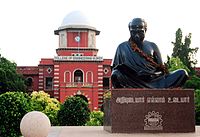 The statue of Annadurai at the College of Engineering, Guindy campus of Anna University which is named after him
The statue of Annadurai at the College of Engineering, Guindy campus of Anna University which is named after him
Annadurai was the only political leader at the national level in India during his era who was not involved in the Indian independence movement.[35] After his electoral success with his DMK in 1967, the Congress has not yet returned to power in Tamil Nadu. His government was the first in the country to be from a non-Congress party with full majority.[33] When the DMK later split, with M. G. Ramachandran forming his own Dravidian party, the rebel fragment was named after Annadurai as Anna DMK. Anna Nagar, a residential neighbourhood in Chennai is named after him. Sri Lankan Tamil nationalist leaders and writers are considered to be influenced by Annadurai's chaste Tamil movement.[44] Anna University, a premier institution in science and technology was named after him. DMK's current head office built in 1987 is named after him as Anna Arivalayam.[45] One of the major roads in Chennai was named in his honour, Anna Salai--it was previously called Mount Road, and a statue of Annadurai now stands there.[46] The central government issued a commemorative coin of
 5 denomination to mark the centenary celebrations of him on Sep 15, 2009 in Chennai.[47] Jawaharlal Nehru hailed him as one of the great parliamentarians for speeches in Rajya Sabha.[48] Selig Harrison, an US based[49] analyst of South Asian and East Asian politics and journalism[50] commented
5 denomination to mark the centenary celebrations of him on Sep 15, 2009 in Chennai.[47] Jawaharlal Nehru hailed him as one of the great parliamentarians for speeches in Rajya Sabha.[48] Selig Harrison, an US based[49] analyst of South Asian and East Asian politics and journalism[50] commented“ There is no doubt that this powerful orator is the single-most popular mass figure in the region[35] ” The magazine India Today has listed Annadurai in its "Top 100 people who shaped India by thought, action, art, culture and spirit".[51] In 2010, Anna Centenary Library was established in Chennai in remembrance of Annadurai.[52]
Filmography
Year Film Credits.[53] 1949 Nallathambi Story, Screenplay and Dialogues 1949 Velaikaari Story, Screenplay and Dialogues 1951 Or Iravu Story and Dialogues 1954 Sorgavasal Story and Dialogues 1956 Rangoon Radha Story 1959 Thaai magalukku kattiya thali Story Edhayum Thangum Idhayam Story 1961 Nallavan Vazhvaan Story 1970 Kadhal Jothi Story 1978 Vandikaaran magan Story Anna's first movie script, of his play Velaikkari, fetched him a fee of Rs.12000 INR, a considerable sum at that time [54]
Apart from his stories, the names of some of Annadurai's works were used as film titles for Panathottam (1963), Valiba virundhu (1967), Kumarikottam (1971), Rajapart Rangadurai (1973), Needhi devan mayakkam (1982).[53]
Bibliography
Fiction
Year Type Work First appeared in[53] 1939 Novella Komalathin Kobam Kudi arasu 1939 Novella Kabothipura Kadhal Kudi arasu 1942 Novella Kumasthavi penn or Kolaikariyin Kurippugal Dravida Nadu 1942 Novella Kalingarani Dravida Nadu 1943 Novella Parvathi B.A Dravida Nadu 1943 Play Chandrodhayam 1945 Novella Dasavatharam Dravida Nadu 1945 Play Sivaji kanda indhu samrajyam 1946 Play Velaikaari 1946 Novella Kumari kottam Dravida Nadu 1946 Novella Rangoon Radha Dravida Nadu 1947 Play Needhidevan mayakkam 1947 Parable Kadhiravan Kaneen Dravida Nadu 1948 Play Nallathambi 1948 Play Or iravu 1948 Novella En vazhvu Dravida Nadu 1953 Play Sorgavasal 1953 Play Kadhal jothi 1955 Parable Kumari Surya Dravida Nadu 1955 Parable Nangai Nagaithaal Dravida Nadu 1955 Parable Oru muttalin kadhai Dravida Nadu 1955 Play Pavayin payanam 1956 Novella Pudhiya polivu Dravida Nadu 1957 Novella Kadaisi kanavu Dravida Nadu 1965 Novella Thazhumbukal Kanchi 1965 Novella Vandikaaran magan Kanchi 1968 Novella appodhae sonnen Kanchi 1970 Play Inba oli Kanchi and Dravida nadu Non fiction
Year Title[1] 1947 Kambarasam 1948 Ariyamayai Photo gallery
-
K. A. Mathialagan, Annadurai and M. Karunanidhi
-
Annadurai (centre and leaning towards right) with K. A. Mathialagan, V. P. Raman, Rajaji and M. Karunanidhi
-
The memorial of Anna, the first CM of Dravidian Parties of Tamil Nadu at Marina Beach in Chennai
See also
- List of places named after C. N. Annadurai
References
- ^ a b c d e f g h "Life History and Literary Works of C.N. Annadurai". Tamil Electronic Library. http://tamilelibrary.org/teli/anna.html. Retrieved 2008-12-20.
- ^ a b c d e f Karunanidhi, Muthuvel. "Annadurai.C.N (1909-1969)". Vandemataram.com. http://www.vandemataram.com/biographies/patriots/annadurai.htm. Retrieved 2008-12-20.
- ^ a b c d e f Satyendra, Kuśa (2000). Dictionary of Hindu Literature. Sarup & Sons. pp. 9–10. ISBN 8176251593. http://books.google.com/?id=UcAwrV60cpAC.
- ^ P.6 "Anna- The Life and times of C N Annadurai" By R. Kannan
- ^ P. 66 Daughter of the South By Pi. Ci Kaṇēcan̲
- ^ P. 41 Ethnic movement in India By Ganapathy Palanithurai, R. Thandavan
- ^ P. 25 C.N. Annadurai By Pi. Ci Kaṇēcan̲
- ^ a b c d Rajwat, Mamta (2004). Encyclopaedia of Dalits in India. Anmol Publications PVT. LTD. pp. 246–247. ISBN 8126120843. http://books.google.com/?id=ocjlRwK1y5cC.
- ^ a b Ralhan, O.P. (2002). Encyclopaedia of Political Parties. Anmol Publications PVT. LTD.,.. pp. 125–128. ISBN 8174888659. http://books.google.com/?id=P4lCjG1DUV4C&pg=PA423&dq=Madras+Dravidian+Association.
- ^ Wilkinson, Steven I (2006). "Caste mobilization in Pre-independence Madras". Votes and Violence: Electoral Competition and Ethnic Riots in India. Cambridge University Press. pp. 189–192. ISBN 0521536057. http://books.google.com/books?id=tLpRFbLSxvAC. Retrieved 2008-12-16.
- ^ a b c Kandasamy, W.B. Vansantha; Florentin Smarandache; K. Kandasamy (2005). Fuzzy and Neutrosopohc Analysis of Periyar's Views on Untouchability. HEXIS: Phoenix. p. 106. ISBN 9781931233002. http://books.google.com/?id=hgb-MKcsSR0C&printsec=frontcover&dq=Fuzzy+and+neutrosophic+analysis+of+Periyar%27s+views+on+untouchability#PPA106,M1.
- ^ a b Sarah, Dickey (1993). "The Politics of Adulation: Cinema and the Production of Politicians in South India". The Journal of Asian Studies (Association for Asian Studies) 52 (2): 340–372. doi:10.2307/2059651. JSTOR 2059651.
- ^ a b c Rajagopalan, Swarna (2001). State and Nation in South Asia. Lynne Rienner Publishers. pp. 152–154. ISBN 1555879675. http://books.google.com/?id=q7Yz5aGeoTsC.
- ^ Ramaswamy, Cho. "E.V. Ramaswami Naicker and C.N. Annadurai". India Today. http://www.india-today.com/itoday/millennium/100people/durai.html. Retrieved 2008-12-19.
- ^ a b c d e f g h i j k l m n Asaan, GVK (2008). "Anna the genius". The birth centenary of Arignar Anna (C.N.Annadurai- 15 September 1909 - 3 February 1969) is being celebrated between September 2008 and September 2009. The first part of his life sketch appeared in the September issue. In this issue we give the second and the concluding part. Modern Rationalist. http://www.themronline.com/200810mr/page14.html. Retrieved 2008-12-20.
- ^ Priest-less weddings in TN VIP families - Sify News
- ^ Subramanian, RS (September 26 - October 09, 1998). Celebrating a half century "Celebrating a half century". Frontline, The Hindu Publishing. http://www.hindu.com/fline/fl1520/15201330.htm Celebrating a half century. Retrieved 2008-02-19.
- ^ a b Phadnis, Urmila; Rajat Ganguly (2001). Ethnicity and Nation-building in South Asia. SAGE. pp. 227. ISBN 0761994394. http://books.google.com/?id=wbf2wzyuWkUC.
- ^ Ganguli, Amulya (2007-05-26). "The DMK’s negative politics". The Tribune, India. http://www.tribuneindia.com/2007/20070526/edit.htm. Retrieved 2008-12-20.
- ^ Bukowski, Jeanie J; Swarna Rajagopalan (2000). Re-distribution of Authority. Greenwood Publishing Group. pp. 19–21. ISBN 0275963772. http://books.google.com/?id=mgK1Fltsh4cC.
- ^ Jain, Sumitra Kumar (1994). Party Politics and Centre-state Relations in India. Abhinav Publications. pp. 142. ISBN 8170173094. http://books.google.com/?id=Gm9p_VPDZCgC.
- ^ a b c d e f g Hardgrave, Robert (1965). "The Riots in Tamilnad: Problems and Prospects of India's Language Crisis". Asian Survey 5 (8): 399–407. doi:10.1525/as.1965.5.8.01p0095g. http://caliber.ucpress.net/doi/abs/10.1525/as.1965.5.8.01p0095g. Retrieved 2008-12-20.
- ^ Thirumavalavan; Meena Kandasamy (2004). Uprrot Hindutva. Popular Prakashan. pp. 125–126. ISBN 8185604797. http://books.google.com/?id=HfNRO-LtsN4C.
- ^ Nandivarman, N (2008-01-27). "Remembering the 1965 Anti Hindi Struggle". Tamil Nation. http://www.tamilnation.org/forum/nandivarman/080127hindi.htm. Retrieved 2008-12-20.[dead link]
- ^ Viswanathan, S (April 10 – 23, 2004). "A history of agitational politics". Frontline, The Hindu publishing. http://www.flonnet.com/fl2108/stories/20040423007201600.htm. Retrieved 2008-12-19.
- ^ Amaresh Datta., 2005., Extempore Literature (Tamil): The Encyclopaedia Of Indian Literature (Volume Two) (Devraj To Jyoti) Volume 2 (Page 1249-50).
- ^ a b c d e Hardgrave, Jr, Robert L (March 1973). "Politics and the Film in Tamilnadu: The Stars and the DMK". Asian Survey (JSTOR) 13 (3): 288–305. doi:10.1525/as.1973.13.3.01p0314o.
- ^ Bhanskaran, Gautaman (2008-08-2008). "Pioneers who pushed cinema into politics". The Japan Times online. http://search.japantimes.co.jp/cgi-bin/eo20080829gb.html. Retrieved 2008-12-13.
- ^ a b Guneratne, Anthony R.; Wimal Dissanayake, Sumita S. Chakravarty (2003). Rethinking Third Cinema. Routledge. pp. 216. ISBN 0415213541. http://books.google.com/?id=2IFR0oHGHKUC.
- ^ Ramanujam, KS (1967). The big change. Higginbothams. pp. 226. http://books.google.com/?id=dYIhAI1tNnEC&dq=.
- ^ a b {{cite book Occasion tickets were sold for his speeches, perhaps a first in the history of speech-making in India. His speeches were almost the first to be published in booklet form. | last = Various authors | title = Encyclopaedia of Indian literature vol. 1 | publisher = Sahitya Akademi | year = 1987 | location = | pages = 181 | isbn = 8126018038}}
- ^ p.79," Anna - Life and times of C N Annadurai by R Kannan
- ^ a b Chakrabarty, Bidyut (2008). Indian Politics and Society Since Independence. Routledge. pp. 110–111. ISBN 0415408687. http://books.google.com/?id=QzQHZ178C24C.
- ^ Viswanathan, S (April 10–23, 2004). "Dravidian power". Frontline. http://www.frontline.in/fl2108/stories/20040423007701500.htm. Retrieved 2008-02-19.
- ^ a b c d Venkatachalapathy, AR (2008-04-10). "C.N. ANNADURAI — POLITICIAN, 1909-1969". http://indiatoday.digitaltoday.in/index.php?option=com_content&issueid=48&task=view&id=6878&acc=high. Retrieved 2008-12-20.
- ^ Venkatesh, MR (2004-06-07). "Solidarity show at wedding - ADMK’s brickbats on cauvery mixes with Pranab’s bonhomie". The Telegraph, Calcutta. http://www.telegraphindia.com/1040607/asp/nation/story_3340313.asp. Retrieved 2008-12-20.
- ^ Hodges, Sara (2005). "Revolutionary family life and the Self Respect movement in Tamil south India". Contributions to Indian Sociology 39 (2): 251–277. doi:10.1177/006996670503900203. http://cis.sagepub.com/cgi/content/abstract/39/2/251. Retrieved 2008-12-20.
- ^ "Rice promises stir Tamil Nadu". Rediff.com. 2006-04-19. http://in.rediff.com/election/2006/apr/19ptn.htm. Retrieved 2008-12-20.
- ^ Jayakanthan, Dandapani (2006). A Literary Man's Political Experiences. Read books. pp. 212. ISBN 1406735698. http://books.google.com/?id=Lnl_um7uFcsC.
- ^ C. N. Annadurai: a timeline, THE HINDU 15 September 2009.
- ^ Kannan, R (2004-09-15). "Remembering Anna". The Hindu. http://www.hinduonnet.com/2004/09/15/stories/2004091503061000.htm. Retrieved 2008-12-20.
- ^ McFarlan, Donald; Norris McWhirter (1990). Guinness Book of World Records, 1990. Bantam Books. pp. 400. ISBN 9780553284522. http://books.google.com/?id=y8Pm70o2tmoC&q=Annadurai+%2215+million%22+funeral&dq=Annadurai+%2215+million%22+funeral.
- ^ Kishore, BR. India - A Travel Guide. Diamond Pocket Books (P) Ltd. pp. 702. ISBN 8128400673. http://books.google.com/?id=COHI7LlpkSAC.
- ^ Wilson, Jeyarathnam (2000). Sri Lankan Tamil Nationalism. C. Hurst & Co. Publishers. pp. 37. ISBN 1850655197. http://books.google.com/?id=5AQcVvbHzdcC.
- ^ "The Rising Sun". Dravida Munnetra Kazhagam. http://www.dmk.in/rsun.html. Retrieved 2008-12-20.
- ^ Muthiah, S (2003-07-02). "Round Tana and around". The Hindu. http://www.hinduonnet.com/thehindu/thscrip/print.pl?file=2003070200210300.htm&date=2003/07/02/&prd=mp&. Retrieved 2008-12-20.
- ^ "Release Of Coin on Sh C N Annadurai". INDIAN STAMP GHAR. 2009-09-16. http://www.indianstampghar.com/2009/09/news-release-of-coin-on-c-n-annadurai/. Retrieved 2010-09-15.
- ^ "Tamil Nadu celebrates Annadurai's birth centenary". IBN live. 2008-09-15. http://ibnlive.in.com/news/tamil-nadu-celebrates-annadurais-birth-centenary/73600-15-single.html. Retrieved 2008-12-20.
- ^ C.N. ANNADURAI — POLITICIAN, 1909-1969, indiatoday.in A.R. Venkatachalapathy, 10 April 2008, Updated 17:40 IST
- ^ "Selig Harrison". CIP. http://www.ciponline.org/asia/Seligbio.html. Retrieved 2008-12-19.
- ^ E.V. Ramaswami Naicker and C.N. Annadurai, By Cho S. Ramaswamy, india-today.com
- ^ Chennai now boasts South Asia’s largest library
- ^ a b c "C.N. Annadurai - List of creative works" (in Tamil). Government of Tamil Nadu. http://anna100.tn.gov.in/padaippu_%20pattial_003.html. Retrieved 2009-01-18.[dead link]
- ^ P.82," Anna-Life and times of C N Annadurai by R. Kannan
Preceded by
NoneGeneral Secretary of the Dravida Munnetra Kazhagam
1949 - 1956Succeeded by
V. R. NedunchezhiyanPreceded by
DeivasigamaniMember of Madras State Legislative Assembly
1957 - 1962Succeeded by
S. V. Natesa MudaliarPreceded by Leader of Opposition in Madras State Legislative Assembly
1957 - 1962Succeeded by Preceded by Member of Madras Legislative Council
1967 - 1969Succeeded by Preceded by
M. BakthavatsalamChief Minister of Madras State (Tamil Nadu from August 1968)
1967 - 1969Succeeded by
V. R. Nedunchezhiyan (acting)External links
- C.N.Annadurai: One Hundred Tamils of 20th Century
- C.N.Annadurai centenary: The website for C.N.Annadurai 100th birthday
Dravidian political parties Related topics Periyar E. V. Ramasamy · Dravidian movement · Anti-Hindi agitations · Cinema in Dravidian politics · Rise of Dravidian partiesForerunners Iyothee Thass · Rettamalai Srinivasan · Natesa Mudaliar · Maraimalai Adigal · Theagaroya Chetty · T. M. NairList of Dravidian partiesDefunct parties Justice party · Tamil National Party · Thazhthapattor Munnetra Kazhagam · Makkal Dravida Munnetra Kazhagam · Thamizhaga Munnetra Munnani · Thayaga Marumalarchi KazhagamCurrent parties Chief Ministers from Dravidian partiesMadras Presidency Tamil Nadu C. N. Annadurai • V. R. Nedunchezhiyan • Karunanidhi • M. G. Ramachandran • Janaki Ramachandran • J. Jayalalithaa • O. PanneerselvamCategories:- Dravida Munnetra Kazhagam politicians
- Chief Ministers of Tamil Nadu
- 1909 births
- 1969 deaths
- Indian Hindus
- People from Kanchipuram District
Wikimedia Foundation. 2010.

